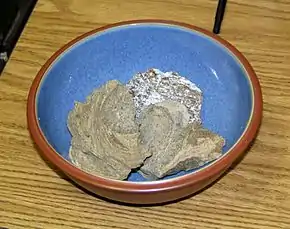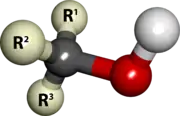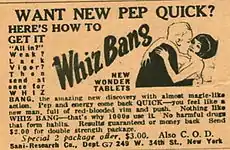Aphrodisiac
An aphrodisiac is a substance that increases sexual desire, sexual pleasure, or sexual behavior.[1][2][3] Substances range from a variety of plants, spices, foods, and synthetic chemicals.[1] Therefore, they can be classified by their chemical properties (i.e., substances that are natural and unnatural).[4] Natural aphrodisiacs like alcohol are further classified into plant-based and non-plant-based substances.[4][5] Unnatural aphrodisiacs like ecstasy are classified as those that are manufactured to imitate a natural substance.[2][4] Aphrodisiacs can also be classified by their type of effects (i.e., psychological or physiological).[1] Aphrodisiacs that contain hallucinogenic properties like Bufo toad have psychological effects on a person that can increase sexual desire and sexual pleasure.[1][3] Aphrodisiacs that contain smooth muscle relaxing properties like yohimbine have physiological effects on a person that can affect hormone levels and increase blood flow.[1][4]
Substances which only affect a person's behavior are susceptible to the placebo effect.[2] Placebo effects are defined as strong beliefs that manifest themselves and therefore are misconstrued to confirm a false positive.[2] It is commonplace to see the placebo effect in the debate on why aphrodisiacs work; those that argue for the placebo effect say that individuals want to believe in the effectiveness of the substance.[2] Other substances that impede on areas that aphrodisiacs aim to enhance are classified as anaphrodisiacs.[2]
Both males and females can benefit from the use of aphrodisiacs, but they are more focused on males as their properties tend to increase testosterone levels rather than estrogen levels.[3] This is in part due to the historical context of aphrodisiacs, which focused solely on males. Only recent attention has been paid to understanding how aphrodisiacs can aid female sexual function.[5] In addition, cultural influence in appropriate sexual behavior from male and females also play a part in the research gap.[5]
History
The name comes from the Greek ἀφροδισιακόν, aphrodisiakon, i.e. "sexual, aphrodisiac", from aphrodisios, i.e. "pertaining to Aphrodite",[6][7] the Greek goddess of love. Throughout human history, food, drinks, and behaviors have had a reputation for making sex more attainable and/or pleasurable. However, from a historical and scientific standpoint, the alleged results may have been mainly due to mere belief by their users that they would be effective (placebo effect). Likewise, many medicines are reported to affect libido in inconsistent or idiopathic ways:[8] enhancing or diminishing overall sexual desire depending on the situation of the subject. For example, Bupropion (Wellbutrin) is known as an antidepressant that can counteract other co-prescribed antidepressants having libido-diminishing effects. However, because Wellbutrin only increases the libido in the special case that it is already impaired by related medications, it is not generally classed as an aphrodisiac.
Ancient civilizations like Chinese, Indian, Egyptian, Roman, and Greek cultures believed that certain substances could provide the key to improving sexual desire, sexual pleasure, and/or sexual behavior.[1][4] This was important because some men suffered from erectile dysfunction and could not reproduce.[1][4] Men who were unable to impregnate their wives and father large families were seen as a failures, whereas those who could were respected. Hence, a stimulant was needed.[1][5] Others who did not suffer from this desired performance enhancers.[4] Regardless of their usage, these substances gained popularity and began to be documented with information being passed down generations.[3] Hindu cultures wrote poems dated back around 2000 to 1000 BC that spoke of performance enhancers, ingredients, and usage tips.[3] Chinese cultures wrote text dated back to 2697 to 2595 BC.[5] Roman and Chinese cultures documented their belief in aphrodisiac qualities in animal genitalia while Egyptian wrote tips for treating erectile dysfunction.[5] In Post-classical West Africa, A volume titled Advising Men on Sexual Engagement with Their Women from the Timbuktu Manuscripts acted as a guide on aphrodasiacs and infertility remedies. It offered advice to men on "winning back" their wives. According to Hammer, "At a time when women’s sexuality was barely acknowledged in the West, the manuscript, a kind of Baedeker to orgasm, offered tips for maximizing sexual pleasure on both sides."[9]
Ambrien, Bufo toad, yohimbine, horny goat weed, ginseng, alcohol, and food are recorded throughout these texts as containing aphrodisiac qualities.[1] While numerous plants, extracts or manufactured hormones have been proposed as aphrodisiacs, there is little high-quality clinical evidence for the efficacy or long-term safety of using them.[8][10]
Types
Ambrien

Ambrien is found in the gut of sperm whales. It is commonly used in Arab cultures as relief medication for headaches or as a performance enhancer. The chemical structure of Ambrien has shown to increase testosterone levels triggering sexual desire and sexual behavior in animal studies only. Further research is needed to know the effects on humans.[3]
Bufo toad
Bufotenin is found in the skin and glands of Bufo toads. It is commonly used in West Indian and Chinese cultures. West Indian cultures use it as an aphrodisiac called 'Love Stone'. Chinese cultures use bufotenin as heart medication called Chan su.[3] Research shows that it can have a negative effect on heart rate.[1]
Yohimbine

Yohimbine is a substance found in the bark of yohim trees in West Africa and, therefore, plant-based.[4] It was traditionally used in West African cultures, in which the bark would be boiled and the resulting water drunk until its effects showed proven benefits in increasing sexual desire.[1] It is now approved by the Food and Drug Administration and can be prescribed for sexual dysfunction in the United States and Canada.[1][5] It is also found in over-the-counter health products.[1] The chemical structure of yohimbine is an indole alkaloid that contains an adrenergic receptor blocker. This blocker affects the central nervous system, autonomic nervous system, and penile tissue and vascular smooth muscle cells that help men with physiological issues and treats psychogenic erectile dysfunction.[1][4] Known side effects include nausea, anxiety, irregular heartbeats, and restlessness.[4]
Horny goat weed
Horny goat weed (Epimedii herba) is used in Chinese folk medicine.[1] It was used to treat medical conditions and improve sexual desire, sexual pleasure, and/or sexual behavior.[1] Horny goat weed contains icariin, a flavanol glycoside.[1][4] Icariin has been shown to improve hormone regulation along with other benefits.[1]
Animal studies show a positive correlation to aphrodisiac qualities, but further research is needed to know the effects on humans.[1][4]
Alcohol

Alcohol has been associated as an aphrodisiac due to its effect as a central nervous system depressant.[5] Depressants can increase sexual desire and sexual behavior through disinhibition.[2][5] Alcohol affects people both physiologically and psychologically, and is therefore difficult to determine exactly how people are experiencing its aphrodisiacal effects (i.e., aphrodisiac qualities or the expectancy effect).[2] Alcohol taken in moderate quantities can elicit a positive increase in sexual desire whereas larger quantities are associated with difficulties reaching sexual pleasure.[2] Chronic alcohol consumption is related to sexual dysfunction.[2]
Marijuana
Marijuana reports are mixed with half of users claiming an increase in sexual desire and sexual pleasure while the other half reports no effect.[2] Marijuana strain, consumption, and individual sensitivity are known factors that affect results.[2]
Food
.jpg.webp)
Many cultures have turned to food as a source of increasing sexual desire; however, significant research is lacking in the study of aphrodisiac qualities in food. Most claims can be linked to the placebo effect aforementioned.[2] Misconceptions revolve around the visual appearance of these foods in relation to male and female genitalia (i.e., carrots, bananas, oysters, and the like).[2][5] Other beliefs arise from the thought of consuming animal genitals and absorbing their properties (i.e., cow cod soup in Jamaica or Ballut in the Philippines).[1] The story of Aphrodite, who was born from the sea, is another reason why individuals believe seafood is another source of aphrodisiacs.[5] Foods that contain volatile oils have gained little recognition in their ability to improve sexual desire, sexual pleasure, and/or sexual behavior because they are irritants when released through the urinary tract.[3] Chocolate has been reported to increase sexual desire in women who consume it over those who do not. Cloves and sage have been reported to demonstrate aphrodisiac qualities but their effects are not yet specified.[1]
Ginseng
Ginseng is the root of any member of the genus Panax.[1][4] Ginseng's active ingredients are ginsenosides and saponin glycosides. There are three different ways to process ginseng. Fresh ginseng is cut at four years of growth, white ginseng is cut at four to six years of growth, and red ginseng is cut, dried, and steamed at six years of growth. Red ginseng has been reported to be the most effective aphrodisiac of the three.[4] Known side effects include mild gastrointestinal upset.[5]
Maca is a Peruvian plant sometimes called "Peruvian ginseng" (but not closely related to Panax). It has been used as a tonic to improve sexual performance.
Synthetic
.svg.png.webp)
Popular party substances have been reported by users to consist of aphrodisiac properties because of their enhancing effects with sexual pleasure. Ecstasy users have reported an increase in sexual desire and sexual pleasure; however, there have been reports of delays in orgasm in both sexes and erectile difficulties in men. Poppers, an inhalant, have been linked to increased sexual pleasure. Known side effects are headaches, nausea, and temporary erectile difficulties.[2]
Phenethylamines
Amphetamine and methamphetamine are phenethylamine derivatives which are known to increase libido and cause frequent or prolonged erections as potential side effects, particularly at high supratherapeutic doses where sexual hyperexcitability and hypersexuality can occur;[11][12][13][14] however, in some individuals who use these drugs, libido is reduced.[12][14]
Testosterone
Libido in males is linked to levels of sex hormones, particularly testosterone.[10][15][16] When a reduced sex drive occurs in individuals with relatively low levels of testosterone, particularly in postmenopausal women or men over age 60,[17] dietary supplements that are purported to increase serum testosterone concentrations have been used with intent to increase libido, although with limited benefit.[10][17] Long-term therapy with synthetic oral testosterone is associated with increased risk of cardiovascular diseases.[18]
Risks
Solid evidence is hard to obtain as these substances come from many different environments cross-culturally and therefore affect results due to variations in its growth and extraction.[4] The same is also true for unnatural substances as variations in consumption and individual sensitivity can affect results.[2] Folk medicine and self-prescribed methods can be potentially harmful as side effects are not fully known and therefore are not made aware to the people searching this topic on the internet.[1][3]
In popular culture

The invention of an aphrodisiac is the basis of a number of films including Perfume: The Story of a Murderer, Spanish Fly, She'll Follow You Anywhere, Love Potion No. 9 and A Serbian Film. The first segment of Woody Allen's Everything You Always Wanted to Know About Sex* (*But Were Afraid to Ask) is called "Do Aphrodisiacs Work?", and casts Allen as a court jester trying to seduce the queen. The "Despair Arc" of Danganronpa 3: The End of Hope's Peak High School features a class being dosed with aphrodisiacs.
See also
References
- Melnyk, John P.; Marcone, Massimo F. (May 2011). "Aphrodisiacs from plant and animal sources—A review of current scientific literature". Food Research International. 44 (4): 840–850. doi:10.1016/j.foodres.2011.02.043.
- Lehmiller, Justin J. (12 October 2017). The psychology of human sexuality (Second ed.). Hoboken, NJ. ISBN 9781119164708. OCLC 992580729.
- Sandroni, Paola (October 2001). "Aphrodisiacs past and present: A historical review". Clinical Autonomic Research. 11 (5): 303–307. doi:10.1007/bf02332975. ISSN 0959-9851. PMID 11758796. S2CID 32348540.
- Bella, Anthony J; Shamloul, Rany (June 2014). "Traditional Plant Aphrodisiacs and Male Sexual Dysfunction: PLANT APHRODISIACS". Phytotherapy Research. 28 (6): 831–835. doi:10.1002/ptr.5074. PMID 25032254. S2CID 29716079.
- Shamloul, Rany (January 2010). "Natural Aphrodisiacs". The Journal of Sexual Medicine. 7 (1): 39–49. doi:10.1111/j.1743-6109.2009.01521.x. PMID 19796015.
- ἀφροδισιακόν. Liddell, Henry George; Scott, Robert; A Greek–English Lexicon at the Perseus Project.
- "Aphrodisiac". Online Etymology Dictionary.
- West E, Krychman M (October 2015). "Natural Aphrodisiacs-A Review of Selected Sexual Enhancers". Sex Med Rev. 3 (4): 279–288. doi:10.1002/smrj.62. PMID 27784600.
- Hammer, Joshua (2016). The Bad-Ass Librarians of Timbuktu And Their Race to Save the World's Most Precious Manuscripts. 1230 Avenue of the Americas New York, NY 10020: Simon & Schuster. p. 27. ISBN 978-1-4767-7743-6.CS1 maint: location (link)
- "Sexual health". Drugs.com. 11 June 2016. Retrieved 17 May 2018.
- Gunne LM (2013). "Effects of Amphetamines in Humans". Drug Addiction II: Amphetamine, Psychotogen, and Marihuana Dependence. Berlin, Germany; Heidelberg, Germany: Springer. pp. 247–260. ISBN 9783642667091. Retrieved 4 December 2015.
- "Adderall XR Prescribing Information" (PDF). United States Food and Drug Administration. December 2013. pp. 4–8. Retrieved 30 December 2013.
- Montgomery KA (June 2008). "Sexual desire disorders". Psychiatry (Edgmont). 5 (6): 50–55. PMC 2695750. PMID 19727285.
- "Desoxyn Prescribing Information" (PDF). United States Food and Drug Administration. December 2013. Retrieved 6 January 2014.
ADVERSE REACTIONS ... changes in libido; frequent or prolonged erections. [emphasis added]
- R. Shabsigh (1997). "The effects of testosterone on the cavernous tissue and erectile function". World J. Urol. 15 (1): 21–6. doi:10.1007/BF01275152. PMID 9066090. S2CID 23591806.
- Fisher, Helen E.; Aron, Arthur; Brown, Lucy L. (29 December 2006). "Romantic love: a mammalian brain system for mate choice". Philosophical Transactions of the Royal Society of London B: Biological Sciences. 361 (1476): 2173–2186. doi:10.1098/rstb.2006.1938. ISSN 0962-8436. PMC 1764845. PMID 17118931.
- Snyder, P. J; Bhasin, S; Cunningham, G. R; Matsumoto, A. M; Stephens-Shields, A. J; Cauley, J. A; Gill, T. M; Barrett-Connor, E; Swerdloff, R. S; Wang, C; Ensrud, K. E; Lewis, C. E; Farrar, J. T; Cella, D; Rosen, R. C; Pahor, M; Crandall, J. P; Molitch, M. E; Cifelli, D; Dougar, D; Fluharty, L; Resnick, S. M; Storer, T. W; Anton, S; Basaria, S; Diem, S. J; Hou, X; Mohler Er, I. I. I; Parsons, J. K; et al. (2016). "Effects of Testosterone Treatment in Older Men". New England Journal of Medicine. 374 (7): 611–624. doi:10.1056/NEJMoa1506119. PMC 5209754. PMID 26886521.
- Borst, S. E; Shuster, J. J; Zou, B; Ye, F; Jia, H; Wokhlu, A; Yarrow, J. F (2014). "Cardiovascular risks and elevation of serum DHT vary by route of testosterone administration: A systematic review and meta-analysis". BMC Medicine. 12: 211. doi:10.1186/s12916-014-0211-5. PMC 4245724. PMID 25428524.
Bibliography
External links
| Wikimedia Commons has media related to Aphrodisiacs. |
